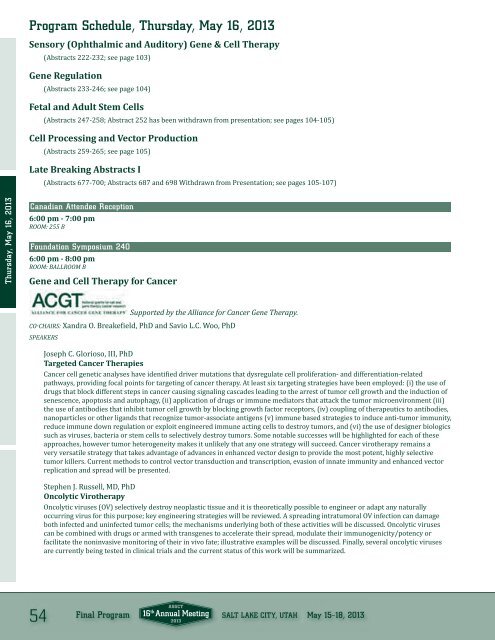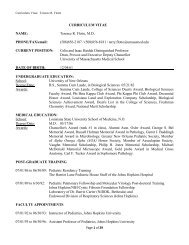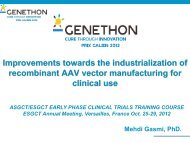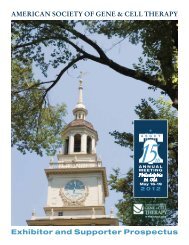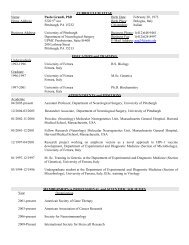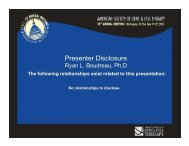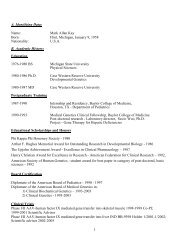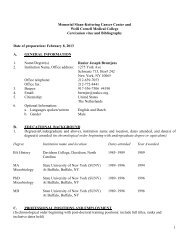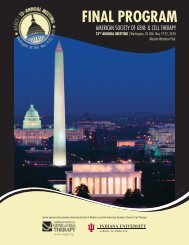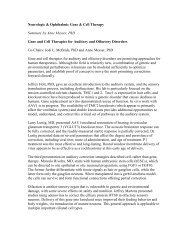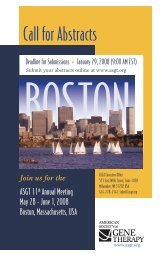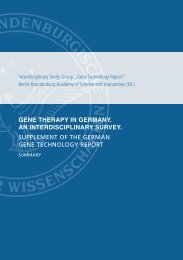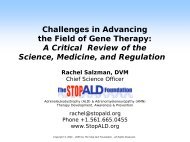Final Program - American Society of Gene & Cell Therapy
Final Program - American Society of Gene & Cell Therapy
Final Program - American Society of Gene & Cell Therapy
You also want an ePaper? Increase the reach of your titles
YUMPU automatically turns print PDFs into web optimized ePapers that Google loves.
<strong>Program</strong> Schedule, Thursday, May 16, 2013<br />
Sensory (Ophthalmic and Auditory) <strong>Gene</strong> & <strong>Cell</strong> <strong>Therapy</strong><br />
(Abstracts 222-232; see page 103)<br />
<strong>Gene</strong> Regulation<br />
(Abstracts 233-246; see page 104)<br />
Fetal and Adult Stem <strong>Cell</strong>s<br />
(Abstracts 247-258; Abstract 252 has been withdrawn from presentation; see pages 104-105)<br />
<strong>Cell</strong> Processing and Vector Production<br />
(Abstracts 259-265; see page 105)<br />
Late Breaking Abstracts I<br />
(Abstracts 677-700; Abstracts 687 and 698 Withdrawn from Presentation; see pages 105-107)<br />
Thursday, May 16, 2013<br />
Canadian Attendee Reception<br />
6:00 pm - 7:00 pm<br />
ROOM: 255 B<br />
Foundation Symposium 240<br />
6:00 pm - 8:00 pm<br />
ROOM: BALLROOM B<br />
<strong>Gene</strong> and <strong>Cell</strong> <strong>Therapy</strong> for Cancer<br />
Supported by the Alliance for Cancer <strong>Gene</strong> <strong>Therapy</strong>.<br />
CO-CHAIRS: Xandra O. Breakeield, PhD and Savio L.C. Woo, PhD<br />
SPEAKERS<br />
Joseph C. Glorioso, III, PhD<br />
Targeted Cancer Therapies<br />
Cancer cell genetic analyses have identiied driver mutations that dysregulate cell proliferation- and differentiation-related<br />
pathways, providing focal points for targeting <strong>of</strong> cancer therapy. At least six targeting strategies have been employed: (i) the use <strong>of</strong><br />
drugs that block different steps in cancer causing signaling cascades leading to the arrest <strong>of</strong> tumor cell growth and the induction <strong>of</strong><br />
senescence, apoptosis and autophagy, (ii) application <strong>of</strong> drugs or immune mediators that attack the tumor microenvironment (iii)<br />
the use <strong>of</strong> antibodies that inhibit tumor cell growth by blocking growth factor receptors, (iv) coupling <strong>of</strong> therapeutics to antibodies,<br />
nanoparticles or other ligands that recognize tumor-associate antigens (v) immune based strategies to induce anti-tumor immunity,<br />
reduce immune down regulation or exploit engineered immune acting cells to destroy tumors, and (vi) the use <strong>of</strong> designer biologics<br />
such as viruses, bacteria or stem cells to selectively destroy tumors. Some notable successes will be highlighted for each <strong>of</strong> these<br />
approaches, however tumor heterogeneity makes it unlikely that any one strategy will succeed. Cancer virotherapy remains a<br />
very versatile strategy that takes advantage <strong>of</strong> advances in enhanced vector design to provide the most potent, highly selective<br />
tumor killers. Current methods to control vector transduction and transcription, evasion <strong>of</strong> innate immunity and enhanced vector<br />
replication and spread will be presented.<br />
Stephen J. Russell, MD, PhD<br />
Oncolytic Virotherapy<br />
Oncolytic viruses (OV) selectively destroy neoplastic tissue and it is theoretically possible to engineer or adapt any naturally<br />
occurring virus for this purpose; key engineering strategies will be reviewed. A spreading intratumoral OV infection can damage<br />
both infected and uninfected tumor cells; the mechanisms underlying both <strong>of</strong> these activities will be discussed. Oncolytic viruses<br />
can be combined with drugs or armed with transgenes to accelerate their spread, modulate their immunogenicity/potency or<br />
facilitate the noninvasive monitoring <strong>of</strong> their in vivo fate; illustrative examples will be discussed. <strong>Final</strong>ly, several oncolytic viruses<br />
are currently being tested in clinical trials and the current status <strong>of</strong> this work will be summarized.<br />
54<br />
<strong>Final</strong> <strong>Program</strong> SALT LAKE CITY, UTAH May 15–18, 2013


